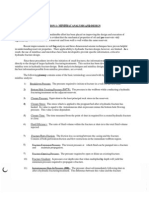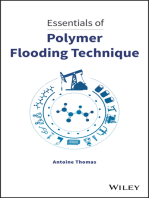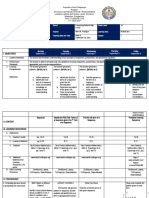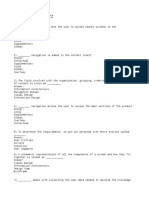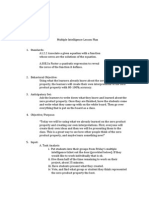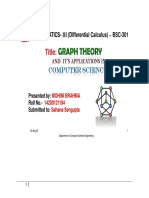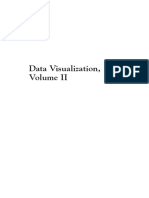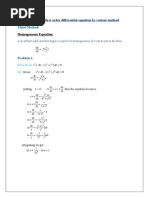SPE Swab Surge Field Validations PDF
SPE Swab Surge Field Validations PDF
Uploaded by
AbhayCopyright:
Available Formats
SPE Swab Surge Field Validations PDF
SPE Swab Surge Field Validations PDF
Uploaded by
AbhayOriginal Title
Copyright
Available Formats
Share this document
Did you find this document useful?
Is this content inappropriate?
Copyright:
Available Formats
SPE Swab Surge Field Validations PDF
SPE Swab Surge Field Validations PDF
Uploaded by
AbhayCopyright:
Available Formats
SPE/IADC 67717
Field Validation of Transient Swab/Surge Response with PWD Data
*
G.Robello Samuel , Ashwin Sunthankar , Glen McColpin , Landmark Graphics, Peter Bern BP, Tim Flynn , Sperry-Sun
*SPE
Copyright 2001, SPE/IADC Drilling Conference
This paper was prepared for presentation at the SPE/IADC Drilling Conference held in
Amsterdam, The Netherlands, 27 February1 March 2001.
This paper was selected for presentation by an SPE/IADC Program Committee following
review of information contained in an abstract submitted by the author(s). Contents of the
paper, as presented, have not been reviewed by the Society of Petroleum Engineers or the
International Association of Drilling Contractors and are subject to correction by the author(s).
The material, as presented, does not necessarily reflect any position of the SPE or IADC, their
officers, or members. Papers presented at the SPE/IADC meetings are subject to publication
review by Editorial Committees of the SPE and IADC. Electronic reproduction, distribution, or
storage of any part of this paper for commercial purposes without the written consent of the
Society of Petroleum Engineers is prohibited. Permission to reproduce in print is restricted to
an abstract of not more than 300 words; illustrations may not be copied. The abstract must
contain conspicuous acknowledgment of where and by whom the paper was presented. Write
Librarian, SPE, P.O. Box 833836, Richardson, TX 75083-3836, U.S.A., fax 01-972-952-9435.
Abstract
This paper describes the results of field validation of the
transient swab, surge model with PWD (Pressure while
drilling) data. The maximum pressures encountered during
tripping-or reciprocation are indispensable for making
appropriate well completion decisions. The prediction of swab
and surge pressures are of critical importance in wells where
the pressure must be maintained within narrow limits of pore
and fracture pressures. It also plays a major role in running
casing, particularly with narrow annular clearances. For these
critical cases, a fully dynamic model is required to better
estimate the maximum pressures encountered.
This paper presents actual surge and swab field data during
tripping and circulating operations collected using PWD tools.
These data were obtained from Alaska and North Sea wells
with a range of hole diameters and with different base fluid
muds. The data were compared and interpreted with a
dynamic surge model, which includes the effects of fluid
inertia and compressibility, wellbore elasticity, axial elasticity
of the pipe, and temperature dependent fluid properties.
The sampling rate was specifically increased to two seconds
and in some cases one second. This is done to prevent
downhole data attenuations and to capture the full waveforms
more accurately. Different operations were included in the
PWD runs to cover swabbing, surging, reciprocation and
simultaneous pumping operations during tripping. Model
predictions of downhole pressure behaviour were in excellent
agreement with the measured PWD data.
Introduction
Qualitative assessment and quantitative characterization of the
well pressures are of critical importance in many phases of the
well construction. They not only allow subsequent
adjustments to the wellplan when combined with payzone geo
steering tools but also successful completion of extended
reach and complex wells.
Increasingly more difficult wells are being drilled with a
narrow margin between pore and fracture pressures. This
requires swab/surge pressures be maintained within the narrow
limits while tripping drillpipe, running casing and cementing.
Operating outside this safe operating window for even short
durations has historically led to costly well complications.
Monitoring the actual downhole pressure in real-time with a
PWD tool is a reliable method however real-time data is
generally confined to periods of continuous circulation. In
addition, it is not possible to run conventional PWD
technology with casing strings. If a reliable predictive
validated model with the real time data is available, it will
help to accurately evaluate transient wellbore pressures at an
early stage of the well planning phase. It also offers a viable
tool to provide accurate data not only in the planning phase
but also to better define the operating limits for both drilling
and casing operations.
Developing confidence in computational predictions requires
the establishment of a rigorous procedure to assure the trends
and magnitudes of the results match reality.This paper focuses
on the validation process.
Background
Pressure surges in critical wells are commonly determined
using steady flow surge models. In these models, the drilling
mud is perfectly displaced by the pipe motion. These models
neglect fluid inertia and the compressibility of the fluid and
wellbore, and the axial elasticity of the pipe. The first fully
dynamic surge pressure model was developed by Lubinski(1).
This model emphasized the importance of compressibility in
pressure calculations. Lal(2) has corrected a number of
deficiencies in the Lubinski model and presented the influence
of various parameters affecting surge pressures. Both Lubinski
and Lal assumed rigid pipe displacement. Mitchell(3,4) added
SAMUEL, SUNTHANKAR, MCCOLPIN, BERN, FLYNN
the effect of pipe axial elasticity to dynamic surge analysis.
The Mitchell model is used in this paper for validation. Not
only does there need to be sufficient engineering detail to
accurately predict swab and surge pressures, but more
importantly issues involving the validity, accuracy, and lack of
data validation need to be addressed, before deciding whether
the model predicts reasonably well. This also allows the model
to be verified. This ensures that the computer simulation
mimics the conceptual model that has been designed and that
the simulation is an accurate representation of the actual
systems considered. Even though the model has been
extensively field validated(5) with an earlier generation of
downhole and surface data, the advent of highly accurate
downhole tools has provided an opportunity to re-validate the
model.
SPE/IADC 67717
The string was pulled out of the hole in singles with
circulation. The PWD data from 3712 ft to 3520ft was used
RKB
110 ft
16 C asing
9 7/8 Hole
INC: 33.5 o , AZ: 240 o ,
4286 ft M D
7 5/8 C asing
Methodology
The PWD data are compared with the dynamic surge/swab
model, which has the capability to include directional wells,
circulation while tripping, dynamic pipe behavior. The
enhanced dynamic model(3) includes fluid inertia, fluid
compressibility, wellbore elasticity, axial elasticity of moving
pipe, temperature dependent fluid rheology for both water and
oil based muds, simultaneous circulation and pipe movement
well deviation and eccentricity.
The data capture rates at the surface and downhole were of
major concern since full dynamic response to swabs and
surges are being studied. The sampling rate of the
measurement was adjusted to every two seconds and in certain
cases four seconds. Simulation indicated that this rate was fast
enough to adequately characterize any transient response. The
method and details of the model involved are beyond the
scope of this paper and explained elsewhere(3).
Well-A
The following case studies are from the data file of Well-A
from North Slope. The well schematic is presented in Fig.1.
Conductor casing of 16 was landed at 110 ft followed by 7
5/8 surface casing to a depth of 4286ft. Further 6 drilling
was in progress.
Case 1 (Swab)
After completion of the drilling 9 7/8 the string was pulled
out of the hole for the 7 5/8 casing job. The string consisted
of the following downhole tools, Jar, Stabilizers, PWD tool,
Positive displacement motor and Tricone bit
The distance to the PWD sensor from the bit = 43 ft
The mud properties at the time of pulling out were as follows:
Mud Weight 9.6 ppg
Plastic Viscosity 27 cP
2
Yield Point 39 lbf/100ft
2
Gel 12 lbf/100ft
Base Water
6 3/4 Open Hole
Figure 1 Well Schematic
for analysis. To account for the six singles pulling out
including the pipe breaking and making time, velocity profile
was used in the simulation for accurate prediction.
1900
Measured
Predicted
1800
Pressure (psi)
Case Studies:
INC: 19.6 o , AZ: 238 o ,
7100 ft M D
1700
1600
1500
1400
1300
0
50
100
150
200
250
300
350
400
450
Time (sec)
Figure 2 Swab with circulation
Figure 2 provides the detailed comparison of the measured and
predicted results. As seen, the predicted results correlate well
with the actual data. In the above case study mud weight was
tuned to match the starting non-uniform hydrostatic gradient.
It can be seen that the peak pressure measured is slightly
higher than the predicted response pressure of the PWD data.
SPE/IADC 67717
FIELD VALIDATION OF TRANSIENT SWAB/SURGE PRESSURE RESPONSE WITH PWD DATA
The data adjustment is justified as settling might have
occurred in the mud column resulting in non-uniform
hydrostatic gradient.
operations including the transition period from the swab and
surge operations. The amplitudes of the characteristics are
very close which again confirmsthat the correlation is good for
each stage of the operation.
Case - 2
2000
1950
1900
Pressure(psi)
During pulling out, tight pull was encountered and after
clearing the tight spots, reciprocation was carried out at a
depth of 4,249.7 ft without circulation. The pipe was
reciprocated between 4,249.7 ft and 4180 ft with variable
stroke length to make sure the tight spot has been cleared. This
operation and data set provides a case for simulating
reciprocation when not circulating. In this case, due to variable
stroke rate velocity profile was used for the simulation. The
mud properties at the time of reciprocation were same as in
Case 1.
The swab and surge pressures during the reciprocation
predicted by the model compared extremelywell with the
PWD data. The peaks and troughs matched closely with wave
oscillation in time. Both the frequency response and amplitude
of the predicted waveforms matched the measured PWD data
closely. At the tail end of the pressure waveform, smoothing
of the peaks is observed and the pressure prediction are within
2%.
1850
1800
1750
1700
Predicted
Measured
1650
1600
0
20
40
60
80
100
120
140
160
Time(sec)
Figure 4 Swab-Surge without circulation
Case 4 (Swab-Surge)
2200
Measured
The following case is concerned with a surge operation from
5,217 ft to 5,285 ft. The waveform character of the predicted
surge pressure agrees well with the data. The data comparison
exhibits the same transient behavior as that of the measured
data but with smaller amplitude at the start and matches
perfectly at the latter part of the waveform. The transient
peaks are strictly a dynamic phenomenon that would not be
predicted by a steady state model.
Predicted
Pressure (psi)
2100
2000
2540
1900
1800
0
50
100
150
200
250
Time (sec)
Figure 3 Reciprocation without circulation
Pressure (psi)
2515
2490
2465
Case 3 (Swab-Surge)
Measured
Predicted
A swab operation followed by a stationary period and a surge
operation is presented below. The operations were carried out
between the measured depths 2,384 ft (Inc-23.87 deg, AZM242.24) and 2,424 ft. (Inc-26.79 deg, AZM-241.43). The
Figure 4 shows the model prediction waveform against the
measured data. The model closely predicts the above
2440
0
30
60
90
Time (sec)
Figure 5 Surge without circulation
120
SAMUEL, SUNTHANKAR, MCCOLPIN, BERN, FLYNN
Well-B
The following case study is from the data file of Well-B
drilled in North Sea. This study of swab-surge pressures for an
offshore deviated well with a water depth of 1,660 ft,. The
well schematic is presented in Fig.6
The string consisted of 500 ft of BHA with the following tools
Jar, MWD tool, Stabilizers, Positive displacement motor and
PDC bit. The distance to the PWD sensor was 53 ft from the
bit.
SPE/IADC 67717
The same adjusted mud density was used in the simulation,
which effectively isolates the influence of the rotary speed. It
can also been seen from Figure 5 that the model predicted the
precise time that the pressure jumps as delineated by the
vertical dotted lines. The model predicted within 2% error.
4000
Measured
Predicted
Pressure (psi)
3900
Well Schematic
0 ft
RKB
Mean Sea Level
1660 ft
3800
Mud Line
3700
36" Structural Drive Pipe
20" Conductor Casing
3600
16" Surface Casing
200
800
1000
Figure 7 Surge with circulation and rotation
56 INC 215 AZM
5571 ft TVD
12 1/4" hole
Summary
62 INC 215 AZM
13287 ft
600
Time (sec)
13 3/8" Intermediate Casing
6023 ft
400
6656 ft TVD
Figure 6 Well Schematic
The mud properties at the time of pulling out was as follows:
Mud Weight 10.87 ppg
Plastic Viscosity 37 cP
2
Yield Point 40 lbf/100ft
2
Gel 27 lbf/100ft Type Synthetic base fluid
Case 3
To demonstate, the ability of the model to predict accurately
the variable reciprocation rate with circulation the following
case was picked from the PWD data. This helps to isolate the
influencing parameters and quantify the capability of the
model. The model presently does not account for the rotation
of the workstring. Reciprocation with variable stroke length
from ,12894ft to 1,2804ft for approximately 20 minutes with
mud circulation and rotation allows a comprehensive
comparison of the model prediction with the data. This
provides a continuous positive pump pressure along with the
drillsting rotation. The rotary speed was 90 rpm and flowrate
was 890 gpm.
Analysis of downhole pressure data show that the
transient model is capable of accurately simulating a
range of complex drilling operations.
The cases presented reinforce several non-intuitive
transient effects such as the observation of surge effects
while swabbing and vice versa.
The data clearly show dynamic and inertial effects not
anticipated by conventional practices but predicted by the
model. The unexpected transient effects observed also aid
in demonstrating that a steady-state analysis may not
always be conservative.
The minordeviation in the predicted values may at least in
part be attributed to the non-uniformity of the wellbore
and failure to account for the elastic response of the
surface equipment.
Based on the excellent agreement between the model and
the measured data, the model portrays accurately the
swab/surge pressures throughout the wellbore.
Acknowledgement
The authors would like to express their appreciation to their
respective companies for the opportunity to present this paper.
Also, the authors would like to take this opportunity to
recognize the contributions of Mitch Bique, and Chris Dalton
of Sperry-Sun. In particular, the authors would lke to
recognize the contributions of Chris Ward, formerly with
Sperry-Sun.
1200
SPE/IADC 67717
FIELD VALIDATION OF TRANSIENT SWAB/SURGE PRESSURE RESPONSE WITH PWD DATA
References
1.
2.
3.
4.
5.
Lubinski, A., Hsu, F. H., and Nolte, K. G. Transient
Pressure Surges Due to Pipe Movement in an Oil Well.
Fevue de lInst. Franc. Du Pet., May June 1977
Lal, Manohar. Surge and Swab Modeling for Dynamic
Pressures and Safe Trip Velocities. Proceedings, 1983
IADC/SPE Drilling Conference, New Orleans.
Mitchell, R. F. Dynamic Surge/Swab Pressure
Predictions., SPE Drilling Engineering, September 1988.
Mitchell, R.F. Surge Pressures: Are Steady-State Models
Adequate? SPE 18021 Annual Technical Conference,
Houston, October 2-5.
Wagner R.R, Halal A.S., Goodman M.A, Surge Field
Tests Highlight Dynamic Fluid Response SPE 25771,
1993 IADC/SPE Drilling Conference, Amsterdam.
SI Metric Conversion Factors
cPx 1.0*E 03 = Pa.s
ft x 3.048*
E-03 = m
in. x 2.54*
E+00 = cm
lbf x 9.869 233 E-00 = N
md x 6.894 757 E-04 = m2
psi x 6.894 757 E+00 = kPa
Conversion factors exact
You might also like
- Solution Manual Convective Heat TransferDocument347 pagesSolution Manual Convective Heat Transfersaintanddevil71% (7)
- Pump Intake Pressure Determined From Fluid Levels Dynamometers and Valve Test MeasurementsDocument13 pagesPump Intake Pressure Determined From Fluid Levels Dynamometers and Valve Test MeasurementsLEONARDO ARZUZANo ratings yet
- SPE-194418-MS Improving Gas Separation in ESP For Unconventional Wells in 5-1 - 2 Casing. Case Studies in The Permian BasinDocument23 pagesSPE-194418-MS Improving Gas Separation in ESP For Unconventional Wells in 5-1 - 2 Casing. Case Studies in The Permian BasinJamesNo ratings yet
- SPE-124295-PP New Integrated Approach For Updating Pore-Pressure Predictions During DrillingDocument11 pagesSPE-124295-PP New Integrated Approach For Updating Pore-Pressure Predictions During DrillingMarcelo Ayllón RiberaNo ratings yet
- Measurement While Drilling: Signal Analysis, Optimization and DesignFrom EverandMeasurement While Drilling: Signal Analysis, Optimization and DesignNo ratings yet
- Modern Borehole Analytics: Annular Flow, Hole Cleaning, and Pressure ControlFrom EverandModern Borehole Analytics: Annular Flow, Hole Cleaning, and Pressure ControlNo ratings yet
- Electromagnetic Well Logging: Models for MWD / LWD Interpretation and Tool DesignFrom EverandElectromagnetic Well Logging: Models for MWD / LWD Interpretation and Tool DesignRating: 5 out of 5 stars5/5 (1)
- Reservoir Engineering in Modern Oilfields: Vertical, Deviated, Horizontal and Multilateral Well SystemsFrom EverandReservoir Engineering in Modern Oilfields: Vertical, Deviated, Horizontal and Multilateral Well SystemsNo ratings yet
- Production EngineeringDocument51 pagesProduction EngineeringRaed fouadNo ratings yet
- Formation Testing: Supercharge, Pressure Testing, and Contamination ModelsFrom EverandFormation Testing: Supercharge, Pressure Testing, and Contamination ModelsNo ratings yet
- Nodal Systems Analysis of Oil and Gas Wells - 00014714Document13 pagesNodal Systems Analysis of Oil and Gas Wells - 00014714Jorge LuisNo ratings yet
- Coiled Tubing Acidizing An Innovative Well Intervention For Production Optimization IJERTV4IS060548Document4 pagesCoiled Tubing Acidizing An Innovative Well Intervention For Production Optimization IJERTV4IS060548felipealarcontannersamNo ratings yet
- Oilfield Dynamometer Surveys - Pump Card Interpretation & How They WorkDocument5 pagesOilfield Dynamometer Surveys - Pump Card Interpretation & How They WorkMaria JoseNo ratings yet
- 01 Why Do We Need Artificial LiftDocument55 pages01 Why Do We Need Artificial LiftReza Ramadhan0% (1)
- Plunger LiftDocument103 pagesPlunger LiftOscar Guaricallo100% (1)
- Oil and Gas Well Completion TaskDocument4 pagesOil and Gas Well Completion Taskapi-370721250% (2)
- Basics of Fracturing IDocument26 pagesBasics of Fracturing IAnonymous MPRQFuYMMNo ratings yet
- Vol Pore Pressure PredictionDocument525 pagesVol Pore Pressure PredictionPrasanti Plaban Dash100% (3)
- Sliding SleeveDocument13 pagesSliding SleeveSuriya BaluNo ratings yet
- Concepts: Infinite Acting and Boundary Dominated FlowDocument31 pagesConcepts: Infinite Acting and Boundary Dominated Flowhorns2034No ratings yet
- Petroleum Engineering 626 Offshore Drilling Lesson 20: Horizontal WellsDocument10 pagesPetroleum Engineering 626 Offshore Drilling Lesson 20: Horizontal WellsSoufiane HazelNo ratings yet
- Lecture11b - Basic Gaslift Sec 2 - HardwareDocument21 pagesLecture11b - Basic Gaslift Sec 2 - Hardwarereborn2100% (1)
- Lecture12a - Basic Gaslift Sec 4 - UnloadingDocument28 pagesLecture12a - Basic Gaslift Sec 4 - Unloadingreborn2100% (2)
- AquaLift SystemDocument2 pagesAquaLift SystemGandhi HetamiNo ratings yet
- 1985 - A Simulator For Gas Kicks in Oil-Based Drilling MudsDocument12 pages1985 - A Simulator For Gas Kicks in Oil-Based Drilling MudsJonathan Felipe GaldinoNo ratings yet
- Production Optimization: January 21, 2016Document45 pagesProduction Optimization: January 21, 2016Farhad Ali SafiNo ratings yet
- 1.0 A Introduce, Recognize Loading PDFDocument132 pages1.0 A Introduce, Recognize Loading PDFvicbru08No ratings yet
- Wellbore Flow PerformanceDocument7 pagesWellbore Flow PerformanceAhmad KoharNo ratings yet
- Electrical Submersible PumpDocument8 pagesElectrical Submersible Pumpmsyahir_chNo ratings yet
- TIGHT ReservoirDocument25 pagesTIGHT ReservoirMalugu JohnNo ratings yet
- RFT DST MDTDocument1 pageRFT DST MDTMohamed Salah SedekNo ratings yet
- Water Influx EclipseDocument24 pagesWater Influx EclipseDr-Jitendra VaishNo ratings yet
- Reelwell Drilling Method Makes Use of Dual Conduit Drill StringDocument2 pagesReelwell Drilling Method Makes Use of Dual Conduit Drill Stringlulalala8888100% (1)
- Total Well Management IIDocument14 pagesTotal Well Management IIEdgar Tellez100% (1)
- PCS Multi-Stage Plunger LiftDocument16 pagesPCS Multi-Stage Plunger LiftMiguel Urzagaste CruzNo ratings yet
- Reservoir ManagementDocument9 pagesReservoir ManagementlakhanmukhtiarNo ratings yet
- An Investigation On Gas Lift Performance Curve in An Oil-Producing WellDocument15 pagesAn Investigation On Gas Lift Performance Curve in An Oil-Producing WellPenélope MqzNo ratings yet
- Multilateral WellsDocument133 pagesMultilateral WellsBogdan StanciuNo ratings yet
- (SB0A015) FMC Technologies Flow Research and Test CenterDocument12 pages(SB0A015) FMC Technologies Flow Research and Test CenterRoberto Carlos TeixeiraNo ratings yet
- The Fundamentals The FundamentalsDocument55 pagesThe Fundamentals The FundamentalsJose Perozo100% (1)
- Development of A Network and Gas Lift Allocation Model For Production Optimization in The Ras Budran FieldDocument14 pagesDevelopment of A Network and Gas Lift Allocation Model For Production Optimization in The Ras Budran FieldTaiwo Adenike BashorunNo ratings yet
- Characterizing PermeabilityDocument33 pagesCharacterizing PermeabilityAhmed GharbiNo ratings yet
- RTA (Rate Transient Analysis) Fact SheetDocument2 pagesRTA (Rate Transient Analysis) Fact SheetMiguel Angel Vidal ArangoNo ratings yet
- DFIT Analysis ExplainedDocument5 pagesDFIT Analysis Explainednova adriansyahNo ratings yet
- Artificial Lift: Making Your Electrical Submersible Pumps Talk To YouDocument19 pagesArtificial Lift: Making Your Electrical Submersible Pumps Talk To Youamramazon88No ratings yet
- Understanding Downhole Tractors: Gulf Coast Section, SPE Northside, December 12, 2000Document24 pagesUnderstanding Downhole Tractors: Gulf Coast Section, SPE Northside, December 12, 2000southernorNo ratings yet
- Horizontal Drilling With Dual Channel Drill PipeDocument14 pagesHorizontal Drilling With Dual Channel Drill Piperaj kumarNo ratings yet
- Iptc-19506-Ms - Total Well Management - Maximising Well Lifecycle ValueDocument8 pagesIptc-19506-Ms - Total Well Management - Maximising Well Lifecycle ValueAtrian RahadiNo ratings yet
- Pumping Flumping Sucker Rod Lifted WellsDocument12 pagesPumping Flumping Sucker Rod Lifted WellsLEONARDO ARZUZANo ratings yet
- Minifrac Analysis and DesignDocument28 pagesMinifrac Analysis and DesignTarek Tarkan100% (1)
- Smart Well CompletionDocument3 pagesSmart Well Completionasset_kulmagambetovNo ratings yet
- How To Prevent Formation Damage by PetroSkillsDocument16 pagesHow To Prevent Formation Damage by PetroSkillsLinheris D.A SitompulNo ratings yet
- SPE/IADC 67715 Drilling With Rotary Steerable System Reduces Wellbore TortuosityDocument10 pagesSPE/IADC 67715 Drilling With Rotary Steerable System Reduces Wellbore TortuosityMuhammad AndaruNo ratings yet
- Plunger LiftDocument17 pagesPlunger LiftShelo Rosas100% (6)
- High Perm FracturingDocument34 pagesHigh Perm Fracturingkesavan.govinathanNo ratings yet
- Artificial Lift MethodsDocument10 pagesArtificial Lift MethodsMohamed Nazeer Mohd IsmailNo ratings yet
- Exploiting the Digital Oilfield: 15 Requirements for Business ValueFrom EverandExploiting the Digital Oilfield: 15 Requirements for Business ValueRating: 5 out of 5 stars5/5 (1)
- Wave Propagation in Drilling, Well Logging and Reservoir ApplicationsFrom EverandWave Propagation in Drilling, Well Logging and Reservoir ApplicationsNo ratings yet
- Formation Testing: Pressure Transient and Contamination AnalysisFrom EverandFormation Testing: Pressure Transient and Contamination AnalysisNo ratings yet
- HW 1 Data Set - Challenger ORingsDocument3 pagesHW 1 Data Set - Challenger ORingsTerra DrakeNo ratings yet
- Grade 10-Math DLL Week 3Document11 pagesGrade 10-Math DLL Week 3Nikko Patungan50% (2)
- 4469ed0d25b9ed7935ffc45598321b4dDocument7 pages4469ed0d25b9ed7935ffc45598321b4dJay SharmaNo ratings yet
- Vectors GRBDocument9 pagesVectors GRBpalitsoumojit35No ratings yet
- Section Solutions #4: Problem 1: Filling A RegionDocument7 pagesSection Solutions #4: Problem 1: Filling A Regionrahulmnnit_csNo ratings yet
- GRADE 9 Quarter 2 Periodical TestDocument3 pagesGRADE 9 Quarter 2 Periodical TestShiella LobosNo ratings yet
- Lab 08Document7 pagesLab 08Saipreet SantoshNo ratings yet
- Crank ShaftDocument65 pagesCrank ShaftWebsoft Tech-HydNo ratings yet
- External FlowDocument27 pagesExternal Flowraghu.entrepreneurNo ratings yet
- MA 201 Quiz 02 291021 SolutionsDocument3 pagesMA 201 Quiz 02 291021 Solutionsadyasamohapatra5No ratings yet
- VonzkieparabolaDocument7 pagesVonzkieparabolaJohn Ernest MarcoNo ratings yet
- CPM & PertDocument3 pagesCPM & Pertmanojpatel51100% (4)
- Module 3 - Homework AssignmentDocument7 pagesModule 3 - Homework Assignmentkjoel.ngugiNo ratings yet
- AMA 1130 Mid-Term Sample SolDocument4 pagesAMA 1130 Mid-Term Sample SolkentNo ratings yet
- Ed - Tech 1 - LessDocument40 pagesEd - Tech 1 - LessMariel PastoleroNo ratings yet
- Multiple Intelligence LessonDocument3 pagesMultiple Intelligence Lessonapi-216112314No ratings yet
- C2 Zeeman Effect PDFDocument9 pagesC2 Zeeman Effect PDFShweta SridharNo ratings yet
- B TreesDocument4 pagesB TreesdatalogdigitalNo ratings yet
- 12 Construct English Literacy Linus Programme WritingDocument7 pages12 Construct English Literacy Linus Programme Writingmrsmadpager100% (1)
- Vibration Control Chapter Outline: C. R. Yang, Ntnu MT C. R. Yang, Ntnu MTDocument33 pagesVibration Control Chapter Outline: C. R. Yang, Ntnu MT C. R. Yang, Ntnu MTBenny SavioNo ratings yet
- Biscevic Evoluta EvolventaDocument6 pagesBiscevic Evoluta EvolventaDino PracicNo ratings yet
- Gear Guide1Document176 pagesGear Guide1vadiNo ratings yet
- 194 - Mohini Brahma - CA2 - Btech3rdSemDocument20 pages194 - Mohini Brahma - CA2 - Btech3rdSemPriyanshu BanerjeeNo ratings yet
- SamplingDocument50 pagesSamplingSAKHAWAT HOSSAIN KHAN MDNo ratings yet
- CH 4Document26 pagesCH 4Keneni AlemayehuNo ratings yet
- Lesson 12 Kleenes Theorem IIDocument23 pagesLesson 12 Kleenes Theorem IIHussain HbsNo ratings yet
- Data Visualization, Volume IIDocument33 pagesData Visualization, Volume IICharleneKronstedtNo ratings yet
- WORK, POWER, ENERGY & MOMENTUM Important QuestionsDocument18 pagesWORK, POWER, ENERGY & MOMENTUM Important QuestionsRavindra KumarNo ratings yet
- Solution of First Order Differential Equation by Various Method-IiiDocument6 pagesSolution of First Order Differential Equation by Various Method-Iiiadiba adibNo ratings yet

















































